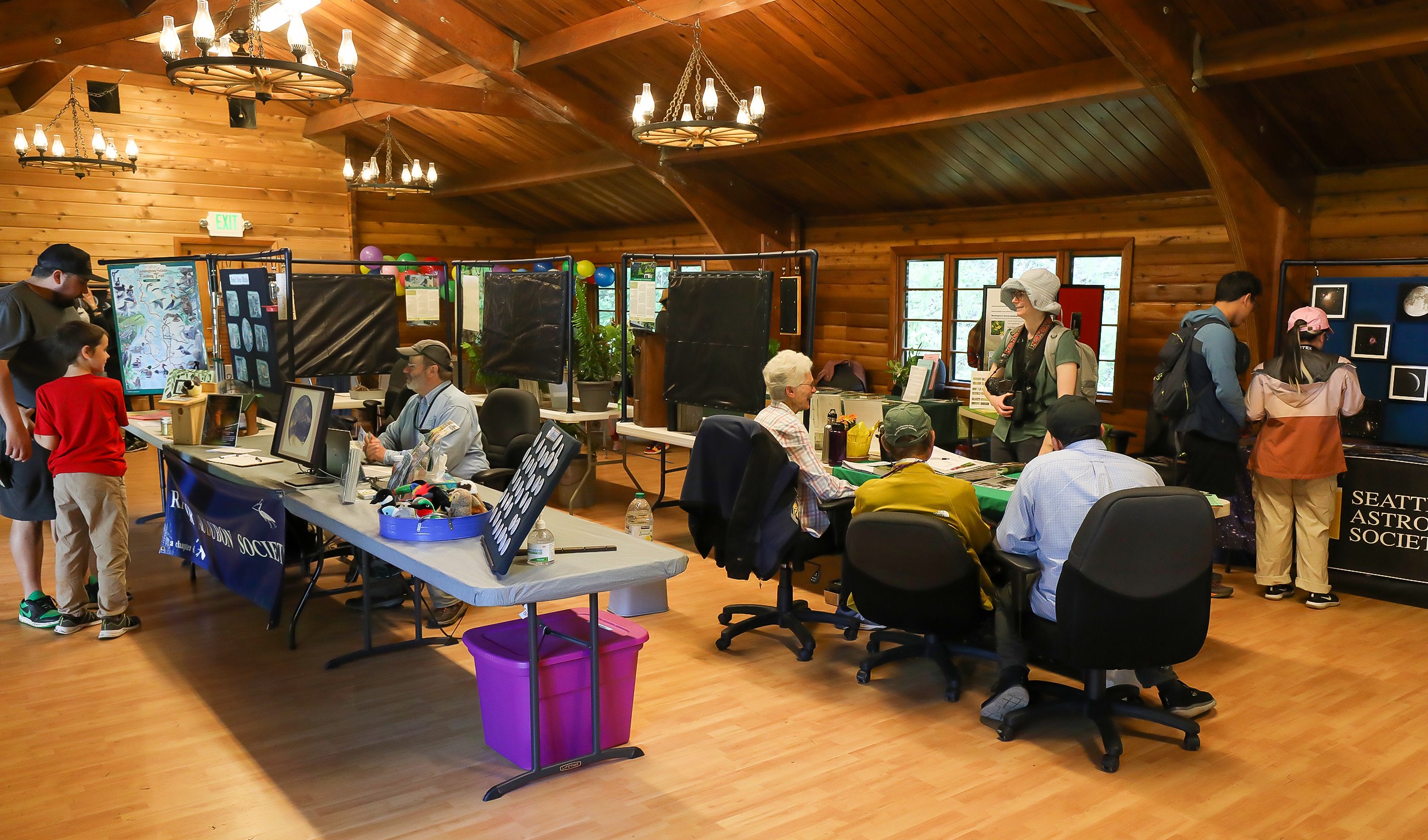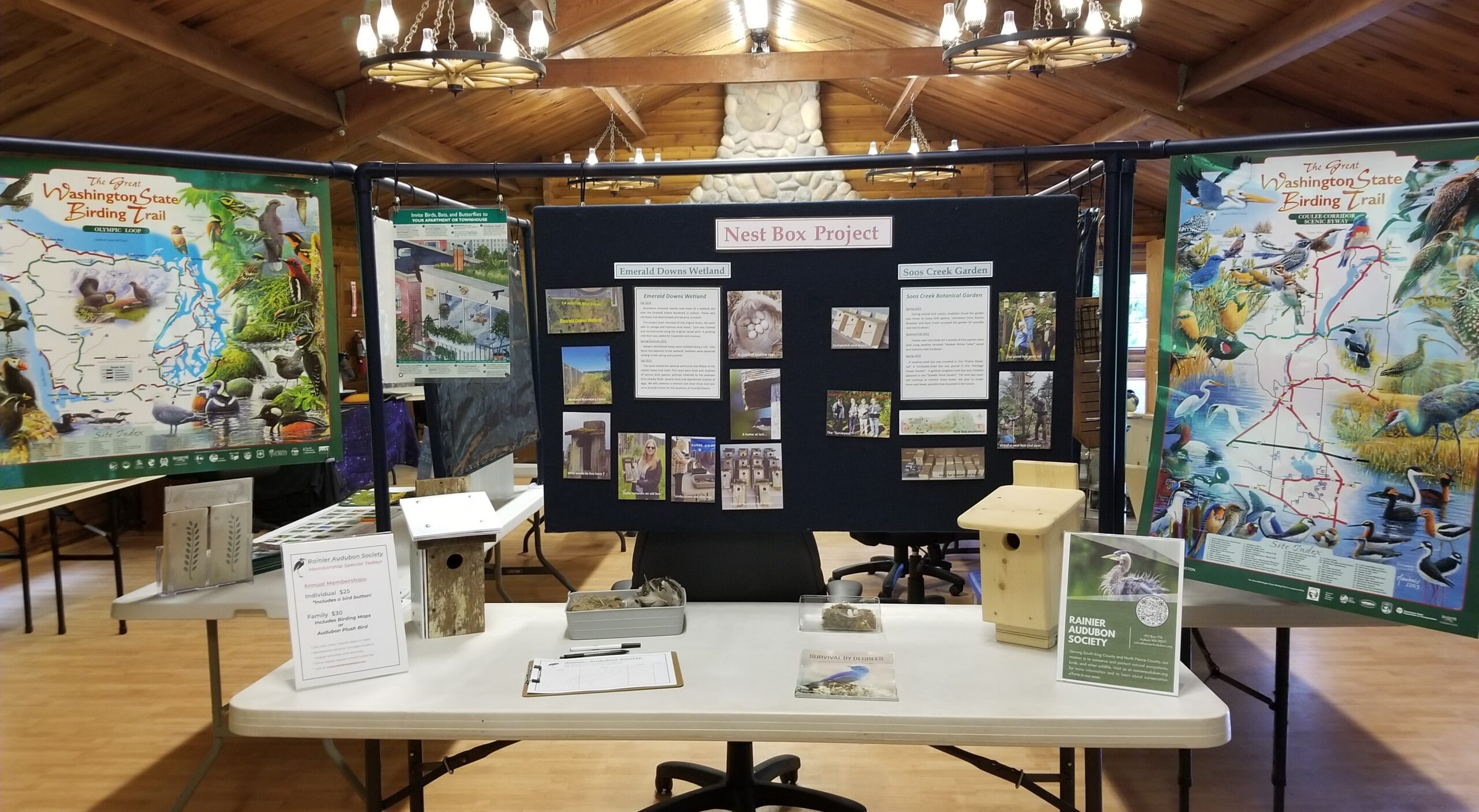

Seem & Heard – October, 2022
By Calen Randall
This summer, I was able to venture out to the Olympic Peninsula, into the Cascades, and over to eastern Washington. There were many highlights and adventures including an American Avocet pair courtship display, meeting up with birding friends Michael and Louise from New Jersey, and a spontaneous evening drive over to the Oak Creek Wildlife Area to find Common Poorwills. Here are a couple of interesting birding adventures from the summer.
July: The White-headed Woodpeckers of Wenas
In July, I explored the ponderosa pine foothills around the Wenas Audubon Campground to find some eastern Cascades woodpeckers. The campground was fairly quiet, but I did find a pair of White-headed Woodpeckers, one of which was banded! Many species at the campground have an intricate relationship with the ponderosa forest, but the White-headed Woodpecker’s connection is especially complicated because of its preference for habitat that has been recently burned. White-headed Woodpeckers are often one of the first species to return to an area after a wildfire because they utilize the soft bark and burnt snags for nesting cavities. However, the woodpeckers still need living pine trees to feed on insects and pine nuts. Historically, White-headed Woodpeckers have thrived along the eastern Cascades, with small burns providing prime nesting habitat, but leaving ample forests for feeding. Changed forest practices to limit fires and more extreme wildfires that leave fewer living trees complicated the wildfire-woodpecker relationship.
Some forestry management research was conducted on White-headed Woodpeckers by Montana State University professor Catherine Wightman and others from the US Department of Agriculture Forest Service in 2010. Their research found that “prefire management activities that open forest canopies and create forest conditions conducive to a mosaic burn pattern by wildfire may encourage white-headed woodpecker nest occupation” and advised forest management groups to leave snags post-fire and utilize prescribed burns. You can read more about their paper here. Wightman’s paper isn’t the only research related to White-headed Woodpeckers. Yakima Nation’s own Jeff Kozma studies the woodpeckers around Kittitas and Yakima County. The bands on the woodpecker I saw were part of a regional woodpecker tracking program led by Kozma. Interestingly, Kozma’s research highlights the importance of wildfires for White-headed Woodpeckers, but found that prescribed burning of shrubs, rather than ponderosa forest positively impacts White-headed Woodpecker nesting productivity. You can read more about Kozma’s work here.
August: A Sunset Spectacle in Packwood

August featured the most impressive aerial show that I’ve ever witnessed. No, it wasn’t the vaunted Blue Angels barreling across the sky, this was a sunset dance of Common Nighthawks! Brushy meadows and clearings amongst thick coniferous forest is prime nighthawk nesting grounds and the Upper Cowlitz Valley around Packwood is full of that habitat. The show opens every evening about an hour before dusk with the first raspy “PEENT” echoing through the air. Somewhere high above the river is the evening’s first nighthawk. Soon one nighthawk becomes two and then three. If you picked the right spot, you could be treated to over a dozen dashing through the air. In flight, the nighthawks put on an enthralling performance. Their white patches flash with their snappy wingbeats and they turn with sublime agility. One moment they can feed on insects and the next they can drop into a dive, with acceleration that would make a Formula One driver envious. The best part of the show is when they pull out of a dive, often when divebombing another nighthawk, and their wings make a whirring boom. Perhaps George Lucas was watching nighthawks when he got his inspiration for the aerodynamics and sounds of the flying ships in Star Wars! One night, friends Michael, Louise, my Mum, and I stayed at a brushy clearing past sunset. The nighthawks flew closer and closer to the ground, their sounds magnified, and you could pick out the details on their wings and the white “V” on their chin. As the nighthawks began disappearing into the brush, one darted an arms length away from me and flapped to the ground! So aerodynamic in the sky, the nighthawk waddled clumsily around the grass, picking at insects in the ground for awhile before disappearing behind a bush. What a stunning end to a phenomenal performance!
September: A “Migration” South
As the evening “peent” of nighthawks changed to the “hoonk” of geese. Hundreds of thousands of birds headed south and for the first time in my life, I joined them on a migration of my own to California to begin my graduate school journey in Atmospheric Science at the University of California Davis. On the drive from Auburn to Davis it was readily apparent that migration was in full force. Droves of Turkey Vultures soared overhead, maximizing the early morning thermals due to unseasonably warm weather. I saw well over a hundred of them soaring over the farmland and mountains.
After a week in Davis, it has been interesting to see so many species that have been featured in various Seen and Heard articles from the past decade. The electric blue flash of an acorn caching California Scrub-Jay reminds me of Frager Road and the first scrub jay residents in the Green River Valley fifteen years ago. Black Phoebes are one of the most abundant passerines in the town of Davis. When I hear them calling outside my bedroom window, I think of the increase in Black Phoebe nesting pairs in the south King County including the phoebes at the Kent Ponds. Will they become more commonplace in the Puget Sound? On my walks through the U Cal Davis campus garden, I see large flocks of Lesser Goldfinch. In the last five years the goldfinches have established themselves in Pierce County, and last November they began visiting my neighborhood in Auburn. Perhaps in another five years they might be a common sight at a community garden in the Green River Valley, too.
It is intriguing not only to think of the birds that have increased their range northward into the Puget Sound region, but also to posit which additional species might be next. The flash of the Acorn Woodpecker’s white wing spot is a common sight in the Valley Oak riparian zones in Davis. Their range extends as far north as the Columbia River in Oregon, but they are not yet established west of the Cascades in Washington. Could those white wing spots become commonplace in the Gary Oak prairies in the south Puget Sound? Maybe the Seen and Heard in October 2032 will have the answer!
It is strange not hearing chickadees around town (you have to go to the foothills to find them) and even stranger not birding in my local region, especially with my Mum. Though writing The Seen and Heard from afar this year will be different, I am excited to weave in stories from my future adventures from around Davis. The Seen and Heard content will remain focused on Washington birding (especially if I get more reports from around home!) but I might incorporate more of a West Coast connectivity approach. As always, send your reports to calenbirds@hotmail.com!
Recent Sightings
August 2022 Raphael Fennimore was on a seabirding tear this summer wracking up sightings mostly from Discovery Park. Spotting a Tufted Puffin in the Puget Sound is hard enough and Horned Puffins are only known to breed on Smith Island (off the coast of Whidbey Island) in Washington, but Raphael managed to find them both in King County multiple times this summer! Other seabird highlights from the Puget Sound this summer include Brown Booby, Leech’s Storm-Petrel, and Nazca Booby. I’m glad to have Raphael’s amazing eyes and ears at Rainier Audubon!
August 29th, 2022 The Point Defiance Dune Peninsula restoration continues to successfully attract new species to the Ruston waterfront, especially shorebirds. In late August, an American Avocet stopped at the breakwater rocks for five minutes, just long enough for some to get photos of the blue-legged shorebird in nonbreeding plumage. In September, Charlie Wright spotted a high flying Long-billed Curlew and Baird’s Sandpipers from the Dune.
September 7th, 2022 Back in December 2021 I wrote about a Lesser Goldfinch flock that began frequenting my neighborhood in late November and hoped they would stick around my yard and be the Rainier Audubon’s first ever Lesser Goldfinches recorded on the Christmas Bird Count. To my excitement, not only did they frequent the neighborhood until the CBC, but they continued well into the spring. In late May the lessers disappeared, perhaps traveling down into the valley to find a cottonwood grove to breed in. The summer was quiet with no sign of any Lesser Goldfinches in the neighborhood. Would the flock return again in November, or had they found a new neighborhood to inhabit? I got my answer in early September when my neighbor Richard texted me a photo of some small yellow finches at his feeder. The Lesser Goldfinches had returned!
September 15th, 2022 Washington is a great state for woodpecker diversity. Visit the Highway 12 corridor or the Cascades in Chelan County and you could see nearly all of our state’s woodpeckers. There is one woodpecker species, the Acorn Woodpecker, that requires a significant detour to see. The Acorn Woodpecker’s Washington range is mostly confined to the oak forests of Klickitat County (Syncline Winery is a great place to taste wine and watch these unique woodpeckers). However—in mid September one Acorn Woodpecker got adventurous and headed on a trip over the Cascades all the way to Magnuson Park in Seattle! Interestingly, the only other Acorn Woodpecker record in Seattle came in September of 2010 also at Magnuson Park!

Bio: After 23 years of searching in his backyard, Calen has yet to find his quest bird, the Blue-footed Booby. Currently a graduate student in Atmospheric Science at the University of California Davis, Calen has spent the last 12 years turning in overdue Seen and Heard articles. Calen loves exploring new habitats in California, but always looks forward to returning home to familiar hotspots in the South Puget Sound



